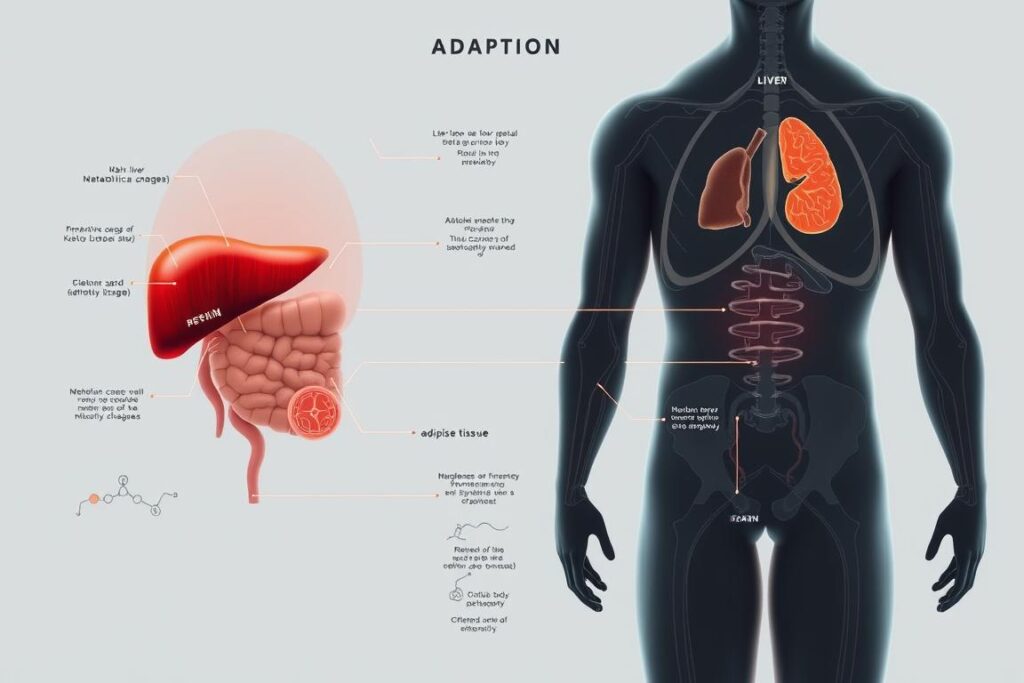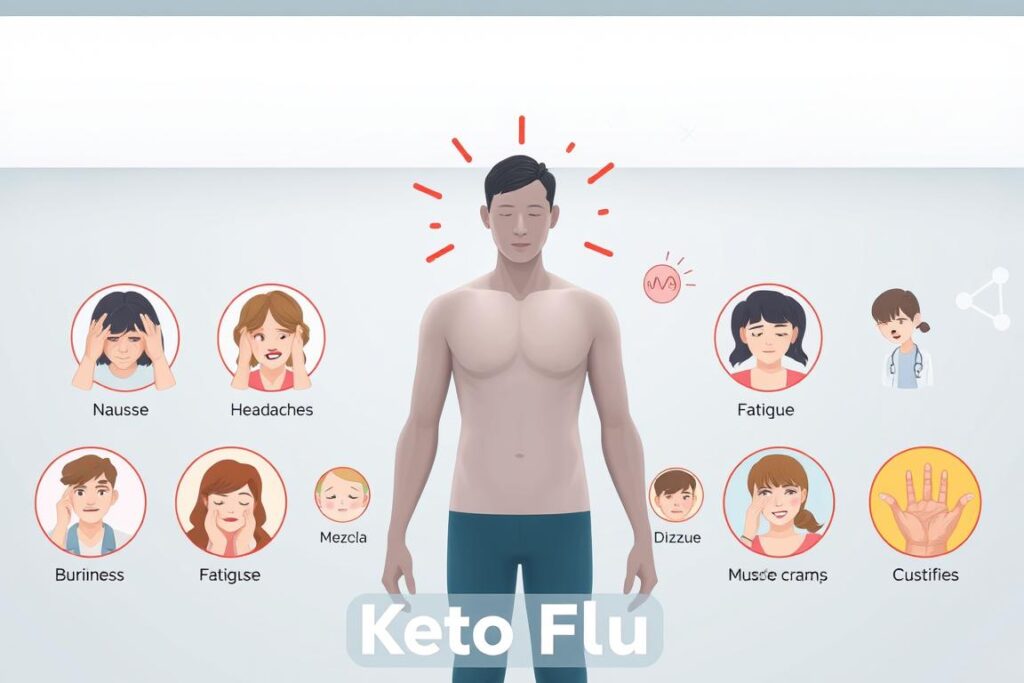Physical Address
304 North Cardinal St.
Dorchester Center, MA 02124
Physical Address
304 North Cardinal St.
Dorchester Center, MA 02124

Discover What Is the Keto Flu? 7 Proven Ways to Beat Symptoms Fast and learn how to manage headaches, fatigue, and nausea while transitioning to ketosis effectively
Ever started a low-carb diet and felt like you’d been hit by a truck? Those headaches, fatigue, and irritability are real. They happen when you switch to ketogenic eating. This is called the keto flu and many people experience it.
The keto flu is a mix of temporary discomforts. They happen when your body starts using fat instead of glucose for energy. This change is hard for your body to get used to.
These symptoms include fatigue, headaches, brain fog, irritability, nausea, and trouble sleeping. They’re tough but usually go away in a few days to weeks. This is when your body gets good at using fat for energy.
The best news? You don’t have to suffer through this. With the right steps, you can ease the discomfort and help your body adjust faster. The solutions are simple and can make your keto journey much better.
Starting a ketogenic diet changes how your body works. It can make you feel sick, known as the keto flu. This feeling is your body adjusting to using fat instead of carbs for energy. Knowing why this happens can help you feel better.
Ketosis happens when you don’t have enough carbs for energy. On a keto diet, you eat very few carbs, about 20-50 grams a day.
With fewer carbs, your body makes less insulin. Insulin helps your body use glucose from food. Without enough insulin, your body starts to use fat for energy instead.

This change in energy source affects your whole body. It’s why you might feel sick during the keto flu.
Your body is used to carbs. Taking them away makes it upset, like withdrawal.
It takes time for your body to learn to use fat for energy. This learning process can make you feel sick. But it’s a sign your body is changing for the better.
This change is good. It means your body is getting used to using fat for energy. Even though it might hurt a bit, it’s a sign of progress.
Knowing this can make the keto flu easier to handle. It shows your body is adapting well to the new diet.
Starting a ketogenic diet can be tough at first. This is because of the keto flu. It happens when your body switches from carbs to fat for energy. Knowing this change is key to getting through the early keto stages.
Keto adaptation is when your body changes from carbs to fat for energy. This shift takes time. It goes through different stages.
The adaptation timeline typically includes:
Even after symptoms go away, your body keeps getting better at burning fat for weeks.

Newbies to keto often get confused about their body’s signals. Some think bad symptoms mean the diet isn’t for them. But, how bad symptoms are doesn’t show how well you’ll do on keto.
Another myth is that not having symptoms means you’re not in ketosis. Some people adjust easily, even if they’re not used to keto. Also, many think keto flu lasts forever, but it usually goes away in days with the right approach.
How you’ve eaten before affects how hard keto flu hits you. People who eat a lot of carbs, like pasta and sugary foods, usually face bigger challenges.
Other things that make you more likely to get keto flu include:
Knowing what might make you more likely to get keto flu helps you prepare. This way, you can make the switch to ketosis easier.
Knowing the signs of keto flu is key to smoothly starting a ketogenic diet. Some people find the transition easy, while others face challenges. Knowing what to expect can help you know when to seek help.
Keto flu symptoms can affect your body in many ways. Gastrointestinal disturbances like nausea and constipation are common. These happen as your body gets used to burning fat instead of carbs.
Headaches and muscle cramps can occur due to electrolyte imbalances. You might also feel weak, tired, and have heart palpitations. This is because your body is adjusting to a new energy source.

Your brain must adapt to using ketones instead of glucose. This can lead to “brain fog,” making it hard to focus and remember things. But, your brain will get better at using ketones over time.
Mood swings are also common. You might feel irritable, short-tempered, or even depressed. Some people also have trouble sleeping or crave carbs. This is your body’s way of saying it misses carbs.
While some discomfort is normal, watch out for serious signs. Severe dehydration and persistent vomiting are big concerns. They need immediate attention.
If you’re extremely tired, have severe heart palpitations, or symptoms get worse, see a doctor. People with health conditions should be extra careful and talk to their doctor often during this time.
Keto flu symptoms usually get better within 3-7 days. If they don’t improve after two weeks, it’s time to get help from a professional.
Starting keto means your body goes through changes. These changes follow a timeline, but everyone’s experience is different. Knowing this timeline helps you get ready and find ways to beat keto side effects early on.
Keto flu symptoms start within 24-48 hours after cutting carbs. They usually get worse around days 2-3. This is when your body is looking for glucose but is starting to use ketones.
The bad news is these symptoms can be tough. But the good news is they don’t last forever. Most people start feeling better in 3-7 days. Some might take up to a month, mainly if they used to eat a lot of carbs.
Several things can change how fast you get through keto flu:
The keto transition has different stages. First, your body uses up all the glucose (days 1-2). Then, your liver starts making ketones, but your cells aren’t good at using them yet (days 3-7).
While symptoms of keto flu usually go away in a week, it takes 3-6 weeks to fully adapt. During this time, your body gets better at burning fat. Many people see their energy, focus, and physical ability keep getting better for months.
Many new keto dieters miss a key strategy: managing electrolytes during the adaptation phase. When you cut carbs, your body changes how it handles minerals. Knowing this helps you beat keto side effects better.
Starting keto lowers your insulin levels. This change makes your kidneys release more sodium. You might lose more sodium in the first weeks than usual.
Potassium helps balance fluids and nerves. But, foods high in potassium like bananas are off-limits on keto. This can lead to a deficiency.
Magnesium is key for over 300 body functions. It helps muscles, energy, and nerves. Without enough, keto adaptation can be tough.
These three electrolytes are vital for cells. Without balance, you get keto flu symptoms.
Knowing electrolyte imbalance signs helps fix the issue. Low sodium can cause headaches, fatigue, and weakness. These are often mistaken for carb withdrawal.
Muscle cramps and heart palpitations might mean you need more potassium. These symptoms are scary but usually get better with supplements.
Low magnesium can lead to muscle twitches, insomnia, anxiety, and constipation. Many find better sleep with magnesium during keto adaptation.
Adding extra salt to your food is simple to boost sodium. Use 1-2 extra teaspoons daily, spread across meals. Sea salt or pink Himalayan salt add extra minerals.
For potassium, eat keto-friendly foods like avocados and spinach. Or use potassium chloride salt substitute. Start small to avoid digestive issues.
Magnesium supplements, like magnesium glycinate, are helpful. Aim for 200-400mg daily, best at night for sleep.
A homemade electrolyte drink can help with all three: mix 1 quart water, ½ teaspoon salt, ¼ teaspoon potassium chloride, and lemon or lime. Drink it all day for better absorption.
Focus on electrolyte balance early in keto to avoid keto flu symptoms. This makes your transition smoother and more lasting.
Learning how to stay hydrated is key to keto success. When you start a ketogenic diet, your body changes how it uses water. This makes drinking enough water important to avoid keto flu symptoms.
On a regular diet, your body stores carbs as glycogen, holding lots of water. Cutting carbs on keto uses up these glycogen stores, leading to more water loss through urine.
This situation creates a perfect storm for dehydration. Your kidneys also get rid of more sodium and water in ketosis. This combo is why many feel very thirsty, have dry mouth, and have concentrated urine.
If you used to drink sugary drinks, you’re more likely to get dehydrated on keto. Drinking enough water is not just about feeling good. It also boosts your energy and can lessen headaches during keto adaptation.
Generic water advice doesn’t work for keto. Start by dividing your weight in pounds by 2 to find your daily water needs.
For example, if you weigh 160 pounds, aim for 80 ounces of water a day. Adjust this based on how active you are, the weather, and how your body reacts. If you’re very active or it’s hot, you might need 20-30% more water.
Make a plan to drink water at set times. Drink 16-20 ounces when you wake up, another 16 ounces before meals, and sip between meals. Using smart water bottles or reminders on your phone can help stay hydrated.
Dehydration and keto flu share some symptoms, making it hard to tell them apart. But, some signs are clearer for dehydration:
“Proper hydration isn’t just about drinking more water—it’s about maintaining the right balance of fluids and electrolytes,” says Dr. Stephen Phinney, a keto diet expert.
Don’t drink too much plain water without electrolytes. This can make mineral imbalances worse. The best strategy is to drink enough water and also take electrolytes to beat keto side effects.
Many people find that easing into a low-carb diet is key to avoiding the flu-like symptoms. By slowly cutting down on carbs, your body can adjust better. This gradual change helps avoid the shock and flu symptoms that come with sudden carb reduction.
Slowing down your carb intake lets your body adjust naturally. Hormones stabilize, and cells learn to burn fat better. This way, you avoid the energy drops, headaches, and mood swings that sudden diet changes can bring.
Also, a slow carb cut helps your mind. It reduces cravings for foods like bread and sweets. This makes the diet change less stressful and boosts your chances of sticking to it long-term.
Here’s a step-by-step plan to ease into ketosis:
Keeping track of carbs is key during your transition. Here are some tools to help:
During the adaptation phase, focus on total carbs to limit glucose intake. This careful method may take longer but can greatly lessen low-carb flu symptoms.
Looking for supplements in the store can be tough. But, some products backed by science really help with keto flu. Eating whole foods is key, but supplements can fill in the gaps and help you adjust to fat-burning.
MCT oil is a quick source of fats that turn into ketones fast. Unlike other fats, MCTs go straight to your liver for ketone making.
Benefits of MCT oil for beating keto side effects:
Start with 1 teaspoon daily and gradually increase to 1-2 tablespoons. Always mix it with food to avoid stomach issues.
Exogenous ketones, like beta-hydroxybutyrate (BHB) salts, boost ketone levels before your body fully adapts. They offer a quick energy boost during the first 1-2 weeks of keto.
Many keto flu symptoms come from electrolyte imbalances. Here are some supplements to consider:
Not all keto supplements work. Avoid these overhyped ones:
Remember, supplements should help, not replace, a good ketogenic diet. Start with the basics (electrolytes and MCT oil) before trying more specialized supplements. This way, you tackle keto flu symptoms effectively, not just follow marketing.
Planning your meals is key to fighting keto flu symptoms. Many focus on the right amounts of macronutrients. But, the quality and composition of your food also matters a lot. Good keto meal plans help your body adjust to the new diet and reduce side effects.
To beat keto side effects, focus on foods that help prevent symptoms. Electrolyte-rich foods should be a big part of your diet.
Avocados are great for keto beginners. They’re full of potassium to stop muscle cramps and keep you energized. Plus, they’re easy to digest.
Bone broth is packed with sodium, minerals, and collagen. It helps with hydration and digestion. Drinking 1-2 cups a day can cut down on headaches and “keto fog.”
Leafy greens like spinach and kale are rich in magnesium and vitamins. They’re low in carbs and help prevent constipation. These veggies also support your body’s cellular functions during the diet change.
Fatty fish like salmon and mackerel are full of omega-3s. These fats reduce inflammation and support brain function when glucose levels drop.
This meal plan slowly cuts carbs and adds healthy fats. It’s made to ease your body’s adjustment:
Day 1:
Day 2:
Day 3:
When starting keto, you might not feel hungry but could get nauseous. This can lead to not eating enough, making symptoms worse. Make sure to eat enough calories. Research shows that good keto meal plans can reduce cravings and lessen symptoms.
Stress can make keto flu symptoms worse. It’s important to manage stress when switching to a keto diet. Stress can affect how you feel physically while adapting to keto. Using stress-reduction techniques can help you feel better faster.
Stress makes your body produce more cortisol, a stress hormone. This can make keto flu symptoms worse. It can cause inflammation, affect blood sugar, and make it hard to use ketones for energy.
Changing how your body uses energy and altering your diet can be stressful. This stress can make headaches, fatigue, and irritability worse. These are common issues when starting keto.
Brief mindfulness sessions can help reduce keto flu symptoms. Just 5-10 minutes of meditation can lower cortisol and ease the transition. Use meditation apps or simple breathing exercises when you feel stressed or irritable.
Gentle yoga can also help with keto adaptation. It improves circulation, reduces muscle tension, and boosts mental clarity. Start with restorative poses in the first week.
Spending time in nature, or “forest bathing,” can also reduce stress. A 20-minute walk outside can help with mental fog and irritability during keto adaptation.
Poor sleep can make keto flu symptoms unbearable. Many people have trouble sleeping during the adaptation phase. It’s important to create the best sleep conditions for a smooth transition.
Reduce caffeine intake to morning hours only. Caffeine can affect sleep quality for up to 12 hours. Make sure your sleeping area is completely dark, without any light from electronic devices.
Try an Epsom salt bath with lavender essential oil before bed. It relaxes muscles and calms your nervous system. This method delivers magnesium and helps you relax before sleep.
Keep your wake times consistent, even on weekends. This helps regulate your sleep patterns and improves sleep quality during keto adaptation.
Exercise doesn’t have to stop when you start keto induction. Making smart changes can make the transition smoother. When your body starts using fat instead of carbs, too much exercise can make keto flu symptoms worse.
The first 1-2 weeks of keto induction are tough. Your glycogen stores are running low, and your body is learning to use ketones. You need to ease up on your workouts.
Try to keep your heart rate under 70% of your max. If you feel too tired, you’re doing too much. Scaling back is a smart move for success in the long run.
Light activities can help with beating keto side effects. They improve circulation and boost your mood. Here are some good options:
Even when you’re tired or sore, moving is good. Try restorative yoga to help your body adjust.
Most people can go back to their usual workouts after 2-3 weeks. Look for these signs to know you’re ready:
When you start again, add intensity slowly. Increase by about 10% each week. This way, you avoid setbacks and keep adapting to keto.
With these 7 proven ways, you’re ready to tackle keto flu symptoms. Electrolyte balance, hydration, and carb reduction are key. Supplements, nutrient-rich meals, stress management, and exercise are also important.
Most people see keto flu symptoms fade in 1-2 weeks. Your body will start burning fat more efficiently. You’ll feel more energetic, have fewer cravings, and better mental focus.
It takes 4-12 weeks to fully adapt to keto. Pay attention to your body. If symptoms last more than ten days or worsen, see a doctor.
Every person’s keto journey is different. Use these strategies to ease discomfort and achieve long-term success. Soon, you’ll enjoy the benefits that made you try keto in the first place.